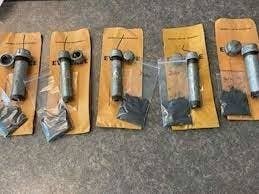
Two California men who authorities say amassed an arsenal of guns and pipe bombs were indicted Thursday over alleged plans to attack targets associated with Democrats.
Ian Benjamin Rogers, 45, of Napa, and Jarrod Copeland, 37, of Vallejo, were charged in federal court with conspiracy to destroy the Democratic headquarters in Sacramento with incendiary devices. Their targets allegedly also included the governor’s mansion and the San Francisco offices of Twitter and Facebook.
The men started planning attacks after former president Donald Trump’s lost the 2020 election by reaching out to an anti-government militia for help, investigators say in an indictment unsealed Thursday. Authorities believe both men are connected to the Three Percenters, a far-right militant group, whose members were involved in the Jan. 6 attack on the Capitol.
According to a detention memo for Copeland, the men also reached out for help from the Proud Boys, the violent neo-fascist group also with several members charged in the Capitol attack.
Rogers and Copeland apparently understood they would be considered domestic terrorists for carrying out the attacks, according to government documents filed in the case, but they hoped that attacks would spark a “movement” to overthrow the US government. In the detention memo, investigators say the men “talked about writing a manifesto (which it appears they never did) to explain their purpose.”
Their planning continued even after the Jan. 6 attack, with Rogers telling Copeland over an encrypted messaging app on Jan. 11, “I want to blow up a democrat building bad,” the indictment says.
While the case is not directly linked to the Capitol insurrection, it highlights federal law enforcement’s drive in the wake of the attack to combat domestic violent extremism, an issue that President Joe Biden, the Justice Department, and the Department of Homeland Security, have made a top priority.
FBI Special Agent in Charge Craig Fair said in a statement Thursday the agency’s “highest priority has remained preventing terrorist attacks before they occur, including homegrown plots from domestic violent extremists.”
Rogers, whose social media shows him to be an enthusiastic Trump supporter, has been in custody since his arrest on Jan. 15 and is being held on $5 million bail. The FBI arrested Copeland in Sacramento on Wednesday.
A search of Rogers' home in January uncovered between 45 and 50 firearms, including at least three fully automatic weapons, thousands of rounds of ammunition, and five pipe bombs that were fully operational, investigators say. They also discovered a Three Percenters sticker and a “white privilege card.”
FBI alleges Ian Rogers, 44, an extremist Trump supporter, made 5 pipe bombs that were fully operational and was intent on attacking Democrats to keep Trump in power. He also had guns, 1000s rounds of ammo, 3 percenters sticker and a "white privilege card." https://t.co/aFZFz5uT9d
Apparently angered by Trump’s election defeat, Rogers and Copeland began plotting attacks over multiple encrypted messaging apps in November 2020. That’s when Rogers allegedly told Copeland that he would “hit the enemy in the mouth” by using Molotov cocktails and gasoline to attack targets associated with Democrats, including the governor’s mansion and the Democratic Headquarters Building in Sacramento, according to investigators.
By Nov. 25, according to the indictment, the two were actively trying to recruit others to join them.
Through one of the apps in late December 2020, Copeland told Rogers that he had contacted an anti-government militia group to get support for their “movement.”
On Jan. 4, according to the Copeland detention memo, Rogers told him, “We need help though and I don’t know how to get more people involved.” Copeland responded, “Proud boys and 3%” and “I emailed proud boys,” investigators say, adding that agents discovered a URL in the internet history on Copeland’s laptop that appeared to show he had filled out and submitted a form on the Proud Boys’ website on or about Dec. 28.
Four days after the Capitol attack, on Jan. 10, the criminal complaint against Rogers says, he told Copeland, “We can attack Twitter and democrats easy right now burn they’re [sic] shit down.”
The next day, according to the indictment, Rogers told Copeland, “I want to blow up a democrat building bad.”
They then agreed on their targets, the indictment alleges, with Rogers suggesting they attack the Democratic Headquarters in Sacramento first. Copeland responded, “Plan attack,” according to investigators.
According to the indictment, Rogers also told Copeland to prepare to “go to war” after Jan. 20, which was Inauguration Day for President Biden and Vice President Kamala Harris.
Four days later, the FBI arrested Rogers and discovered the cache of guns and pipe bombs in his home. When Copeland learned of Roger’s arrest he immediately contacted a militia group to which they both belonged.
One of the militia group’s leaders advised Copeland to switch to a new communications platform and delete all his communications with Rogers after the latter’s arrest, the indictment says. When FBI agents seized Copeland’s electronic devices on Jan. 17, the indictment says, Copeland’s messages with Rogers were missing.
Rogers and Copeland are both charged with conspiracy to destroy by fire or explosive a building used or in affecting interstate commerce. Rogers is also charged with weapons violations, including one count of possession of unregistered destructive devices, and three counts of possession of machine guns. Copeland is charged with the destruction of records for deleting his messages with Rogers.
Attorneys for the men could not be reached for comment on Friday morning, but Rogers’ attorney told the San Francisco Chronicle in January that Rogers didn’t pose a danger to the public and wasn’t a Three Percenters member.
If convicted, the men face a maximum statutory sentence of 20 years imprisonment, a three-year term of supervised release, and a $250,000 fine for the conspiracy charge. Rogers faces an additional maximum of 10 years in prison for the weapons charges, and Copeland faces up to 20 years imprisonment for destroying evidence.
